|
| |
2011 Widescreen Weekend Program
Pictureville, Bradford, England | Read more at
in70mm.com
The 70mm Newsletter
| | Text and images by:
- | Date:
01.01.2011. Updated
22-01-25 |
Friday 25.03.2011
|
|
"Goya" - 10:30
|
|
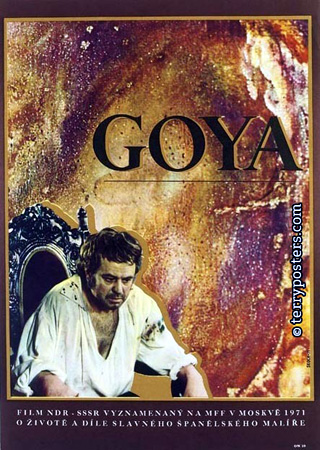  "Goya
– oder der arge Weg der Erkenntnis" / "Goya – or the hard way to enlightment"
(2:16).
Filmed in: 70mm 5 perforations, 24 frames per second.
Principal photography in: DEFA 70. Presented on:
The curved screen in DEFA 70 with 6-track magnetic stereo.
Aspect ratio: 2,21:1. Country of origin: DDR. Production year: 1970.
World Premiere:
16.09.1971,
Kosmos, Berlin, DDR.
Czeck premiere: 20.4.1973. Kino Mir 70
premiere: 9.11.1973.
UK premiere: 24.03.2011, Pictureville, Bradford "Goya
– oder der arge Weg der Erkenntnis" / "Goya – or the hard way to enlightment"
(2:16).
Filmed in: 70mm 5 perforations, 24 frames per second.
Principal photography in: DEFA 70. Presented on:
The curved screen in DEFA 70 with 6-track magnetic stereo.
Aspect ratio: 2,21:1. Country of origin: DDR. Production year: 1970.
World Premiere:
16.09.1971,
Kosmos, Berlin, DDR.
Czeck premiere: 20.4.1973. Kino Mir 70
premiere: 9.11.1973.
UK premiere: 24.03.2011, Pictureville, Bradford
Directed by Konrad Wolf. Director of Photography: W. Bergmann,
K. Ryshow. Cinematography: Werner Bergmann, Konstantin Ryschow.
Music: Kara and Faradsh Karajew. Set Design: Alfred Hischmeier,
Waleri Jurkewitsch. Costume Design: Ludmilla Schildknecht,
Joachim Dittrich. Dramaturge: Walter Janka, Alexander Dymschitz.
Screenplay: Angel Wagenstein. DEFA 1971
Donatas Banionis (Goya), Olivera Vugo (Duchess Alba), Fred Düren
(Esteve), Tatjana Lolowa (Queen Maria Luisa), Rolf Hoppe (King
Carlos IV), Ernst Busch (Jovellanos), Carmen Herold (Maria
Rosario)
In German, with French subtitles
DEFA 70
movies
By Ingolf Vonau,
Berlin, Germany
Certainly the most important and artistic significant 70mm
Feature Film Production of DEFA
Don Francisco de Goya Lucientes (1746 - 1828) is an artist to
the court of Karl IV of Spain. He is well known and well-to-do,
but feels himself becoming more and more remote from the daily
life and suffering of the Spanish people. After meeting the
singer Maria Rosario in a Madrid tavern, where she is singing
revolutionary songs, he becomes even more reflective. Rosario is
hauled before the Inquisition. Goya is invited to attend as a
warning not to stray from the official path. But it doesn't stop
him from increasingly leaving the castle to portray the desires
and nightmares of simple people in his paintings. Soon the
Inquisition is on his trail…
Based on Lion Feuchtwanger's novel "This is the hour – Goya",
and starring the Lithuanian actor Donatas Banionis as main
character, the director Konrad Wolf creates an unconventional
adaptation with images of lasting impressions. Declared aim of
that big DEFA co production with the Russian LENFILM was to
portrait the character of the artist Goya and to show his
painful process of enlightenment in realizing the true Spanish
society. How closely can an artist align himself with the powers
that be if he wants to be honest and creative?
A destiny of an artist as allegory to present. The film was
supposed to be different to the western style of biographical
illustrative screen adaptations in using the cinematographic
tools. Director of Photography Werner Bergmann and his Russian
Colleague Konstantin Ryshow were trying to bring to appear their
special view on how to use wide-screen photography in
filmmaking. According to their principle that only the task not
the possibility demands the format. A point of view sometimes
contrary to the western view of cinematography. At premier night
the 2 part film had a length of 161 min. Some months later the
director himself changed the montage and shortened the film to
134 min. It was his own decision to make the intention in
portraying the painter Goya more understandable. This last
version is the only available one.
Festivals and Awards:
Moscow International Film Festival, Special Jury Award, 1971
|
More in 70mm reading:
Widescreen Weekend 2011
•
Gallery:
2011
•
Mission
Report
• WSW Home
• Through the Years
• The Best of WSW
•
Academy of the WSW
•
Creating the WSW
•
Planning the WSW
• Projecting
the WSW
•
Home of
CINERAMA
•
Projecting CINERAMA
Internet link:
Reel Solutions
|
allmovie.com: Revered Lithuanian actor Donatas Banionis wields the
masterful brush of celebrated Spanish artist Don Francisco deo Goya
Lucientes in this biopic shot in 70mm and directed by Konrad Wolf.
Having attained boundless wealth and iconic status as a painter in the
court of King Carlos IV, Goya falls head over heels for a beautiful
princess while becoming increasingly separated from the suffering of the
Spanish people. Upon hearing singer Maria Rosario sing revolutionary
ballads in a Madrid tavern, however, the detached artist finds becomes
better acquainted with the popular singer while growing more reflective
than ever before. Later, when Marie is brought before the Inquisition,
Goya is invited to witness her trial and becomes acutely aware of the
dangers he should face should he be bold enough to follow her example
and stray from the official path. Over time Goya finds himself unable to
resist the temptation to leave the castle and reconnect with the common
people, a daring action that fuels his creativity while simultaneously
highlighting his disloyalty in the eyes of the Inquisition.
|
|
"Dersu Uzala" 14:30
|
|
  “Дерсу Узала”/ "Dersu
Uzala” (2:24). Filmed in: 70mm, 5 perforations, 24 frames per second. Principal photography in: Sovscope 70. Presented on: The
flat screen in Sovscope 70 with 6-track magnetic stereo. Aspect ratio: 2,21:1. Country of origin: USSR. Production year: 1974 World Premiere: July 1975, Moscow.
UK premiere: June 15th, 1978 Curzon Mayfair, London. “Дерсу Узала”/ "Dersu
Uzala” (2:24). Filmed in: 70mm, 5 perforations, 24 frames per second. Principal photography in: Sovscope 70. Presented on: The
flat screen in Sovscope 70 with 6-track magnetic stereo. Aspect ratio: 2,21:1. Country of origin: USSR. Production year: 1974 World Premiere: July 1975, Moscow.
UK premiere: June 15th, 1978 Curzon Mayfair, London.
Russian version
with English subtitles
Director & writer: Akira Kurosawa. Produced by: Yoichi Matsue & Nikolai Sizov. Original Music by: Isaak Shvarts. Cinematography by: Fyodor Dobronravov, Yuri Gantman & Asakazu Nakai. Art Direction by: Yuri Raksha
Maksim Munzuk (Dersu Uzala), Yuri Solomin (Captain Vladimir Arseniev), Svetlana Danilchenko (Mrs. Arseniev), Dmitri Korshikov (Wowa son of Arsenjev), Suimenkul Chokmorov (Jan Bao), Vladimir Kremena (Turtwigin), Aleksandr Pyatkov (Olenin).
Academy Awards 1976
Best Foreign Language Film
Youtube trailer
|
|
 allmovie.com: A few months after his notorious suicide attempt, Japanese filmmaker Akira Kurosawa was regenerated by the notion of helming the first Russian/Japanese co-production. Co-scripted and directed by Kurosawa, "Dersu Uzala" is the story of an elderly guide and Goldi hunter (Maxim Munzuk), who, at the turn of the century, agrees to shepherd a Russian explorer (Yuri Solomin) and a troop of soldiers through the most treacherous passages of the Far East. allmovie.com: A few months after his notorious suicide attempt, Japanese filmmaker Akira Kurosawa was regenerated by the notion of helming the first Russian/Japanese co-production. Co-scripted and directed by Kurosawa, "Dersu Uzala" is the story of an elderly guide and Goldi hunter (Maxim Munzuk), who, at the turn of the century, agrees to shepherd a Russian explorer (Yuri Solomin) and a troop of soldiers through the most treacherous passages of the Far East.
| |
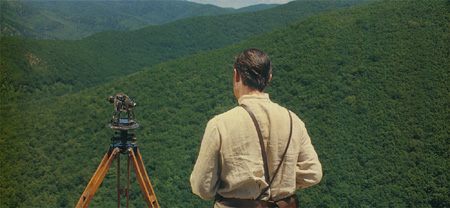 70mm frame scan by Schauburg Kino 70mm frame scan by Schauburg Kino
The guide has been "one" with the land almost from birth, and is thus able to save his party from perishing. Four years in the making, "Dersu Uzala" won the 1976 Best Foreign Film Oscar and restored the flagging Akira Kurosawa to the top ranks of the Japanese film industry.
| |
Widescreen Reception for weekend delegates
+ Academy of the Widescreen Weekend 17:00
|
|
 Reception
guests 2009 - the delegation from Kino Mir 70 in Krnov. Reception
guests 2009 - the delegation from Kino Mir 70 in Krnov.
|
|
The Bridge on the River Kwai - 20:15
|
|
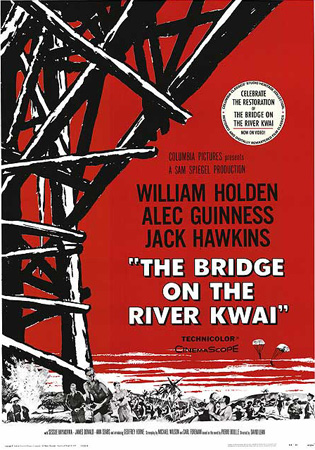 "The
Bridge on the River Kwai" (2:32). Filmed in:
35mm 4 perforations, 24 frames per second. Principal photography in:
CinemaScope. Presented on: The flat screen in a new 4K DCP print
with a new 5.1 digital soundtrack. Aspect ratio: 2,55:1.
Country of origin: UK/USA. Production year: 1957. World
Premiere: 02.10.1957 (UK). "The
Bridge on the River Kwai" (2:32). Filmed in:
35mm 4 perforations, 24 frames per second. Principal photography in:
CinemaScope. Presented on: The flat screen in a new 4K DCP print
with a new 5.1 digital soundtrack. Aspect ratio: 2,55:1.
Country of origin: UK/USA. Production year: 1957. World
Premiere: 02.10.1957 (UK).
Directed by David Lean. Screenplay by Michael Wilson & Carl Foreman.
Produced by Sam Spiegel. Original Music by Malcolm Arnold.
Cinematography by Jack Hildyard. Film Editing by Peter Taylor
William Holden (Shears), Alec Guinness (Col. Nicholson), Jack Hawkins
(Maj. Warden), Sessue Hayakawa (Col. Saito), James Donald (Maj. Clipton).
Academy Awards 1958
Best Actor in a Leading Role Alec Guinness
Best Cinematography Jack Hildyard
Best Director David Lean
Best Film Editing Peter Taylor
Best Music, Scoring Malcolm Arnold
Best Picture Sam Spiegel
Best Writing, Screenplay Based on Material from Another Medium Pierre
Boulle, Carl Foreman, Michael Wilson (Carl Foreman and Michael Wilson
were blacklisted at the time and received no screen credit. They were
posthumously awarded Oscars in 1984.)
Nominated Oscar
Best Actor in a Supporting Role Sessue Hayakawa
Youtube trailer
About showing 4k DCP on a 2k projector. The server scales a 4k DCP down
to 2K DCP and the projector shows it in 2K.
"Kwai"'s
internet page
The Restoration
"The restoration gives back to the film "its original 2:55:1 aspect
ratio," as the film had been "cropped and changed to 2:35:1 shortly
after CinemaScope started." Crisp added: "That's another kind of little
joy I think in doing something like this. We get to see it the way they
actually shot it." Grover Crisp, Sony senior VP for restoration and
mastering, SONY Pictures
|
|
allmovie.com: The Bridge on the River Kwai opens in a Japanese
prisoner-of-war camp in Burma in 1943, where a battle of wills rages
between camp commander Colonel Saito (Sessue Hayakawa) and newly arrived
British colonel Nicholson (Alec Guinness). Saito insists that Nicholson
order his men to build a bridge over the river Kwai, which will be used
to transport Japanese munitions. Nicholson refuses, despite all the
various "persuasive" devices at Saito's disposal. Finally, Nicholson
agrees, not so much to cooperate with his captor as to provide a
morale-boosting project for the military engineers under his command.
The colonel will prove that, by building a better bridge than Saito's
men could build, the British soldier is a superior being even when under
the thumb of the enemy. As the bridge goes up, Nicholson becomes
obsessed with completing it to perfection, eventually losing sight of
the fact that it will benefit the Japanese. Meanwhile, American POW
Shears (William Holden), having escaped from the camp, agrees to save
himself from a court martial by leading a group of British soldiers back
to the camp to destroy Nicholson's bridge. Upon his return, Shears
realizes that Nicholson's mania to complete his project has driven him
mad. Filmed in Ceylon, Bridge on the River Kwai won seven Academy
Awards, including Best Picture, Best Director for the legendary British
filmmaker David Lean, and Best Actor for Guinness. It also won Best
Screenplay for Pierre Boulle, the author of the novel on which the film
was based, even though the actual writers were blacklisted writers Carl
Foreman and Michael Wilson, who were given their Oscars under the table.
|
|
| |
|
Saturday 26.03.2011
|
|
Cineramacana #1 - 10:15
|
|
 Including
"Shellarama" in Super Technirama 70 Including
"Shellarama" in Super Technirama 70
Cineramacana
takes place at Bradford Film Festival each year in March as part of the
Widescreen Weekend and is a fascinating programme of rare bits of films
from the world of 70mm and Cinerama. It started in 1998 and has a
programme that is curated by the Festival team and part created by the
audience who submit or bring there own material, spare reels, shorts and
trailers. The essence is that material should related to Widescreen or
at a push those in the projection booth making it all work. For many
this proves to be one of the highlights of the year and with the
facilities of the National Media Museum's Pictureville Cinema, unique in
Europe, it is an extraordinary show - not least down to one of the best
projection teams in the world. Over the years, people have brought spare
reels of film or extraordinary short films, such as "Internationale",
stunningly made Soviet propaganda in 70mm,
"A Year
Along the Abandoned Road" and a short film that shows every
page of the "Tanakh Bibelen al-Quran"
in less than 5 minutes! For fans of the arcane it is an event not to be
missed.
| |
"The Dark Crystal" - 11:00
|
|
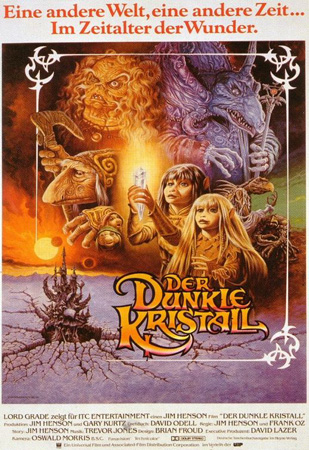 "The
Dark Crystal" (1:36). Filmed in: 35mm 4 perforations, 24 frames per
second. Principal photography in: Panavision. Presented on: The flat
screen in a vintage 70mm print with 6-track Dolby Stereo. Aspect ratio:
2,21:1. Country of origin: UK/USA. Production year: 1982.
World
Premiere: 17.12.1982 (USA) & 17.02.1983 (UK). "The
Dark Crystal" (1:36). Filmed in: 35mm 4 perforations, 24 frames per
second. Principal photography in: Panavision. Presented on: The flat
screen in a vintage 70mm print with 6-track Dolby Stereo. Aspect ratio:
2,21:1. Country of origin: UK/USA. Production year: 1982.
World
Premiere: 17.12.1982 (USA) & 17.02.1983 (UK).
Directed by Jim Henson & Frank Oz. Screenplay by David Odell. Produced
by Jim Henson, Gary Kurtz. Original Music by Trevor Jones.
Cinematography by Oswald Morris. Film Editing by
Ralph Kemplen.
Youtube trailer
| |
allmovie.com: Jim Henson ventures into Tolkien territory in his
all-Muppet fantasy feature The Dark Crystal. The titular Crystal
maintains equilibrium in a mythical kingdom. When the Crystal is broken,
the evil Skeksis take over, killing off the good-guy Gelflings and
enslaving everyone else. Two of the Gelflings have survived: Jen was
raised by the all-knowing Mystics, while Kira grew up amongst the
swamp-dwelling Podlings. Jen and Kira join forces to "heal" the precious
Dark Crystal and restore order to their world. Adults may find the whole
affair a little precious, while children may be disturbed by the film's
mortality rate.
|
|
"How the West Was Won" - 13:30
|
|
 “How the West Was Won”
(2:42) + intermission.
Filmed in:
3x35mm 6 perforations, 24 frames per second.
Principal photography in: Cinerama. Presented:
On the curved
screen in
3-strip “How the West Was Won”
(2:42) + intermission.
Filmed in:
3x35mm 6 perforations, 24 frames per second.
Principal photography in: Cinerama. Presented:
On the curved
screen in
3-strip
 with 7 track
magnetic stereophonic sound.
Angle of view: 146°. Country of origin: USA. Production year:
1961.
World Premiere: 01.11.1962 Casino, London, England.
with 7 track
magnetic stereophonic sound.
Angle of view: 146°. Country of origin: USA. Production year:
1961.
World Premiere: 01.11.1962 Casino, London, England.
Written by James R. Webb. Produced by Bernard Smith. Original Music by
Ken Darby and Alfred Newman. Cinematography by William H. Daniels,
Milton R. Krasner, Charles Lang and Joseph LaShelle. Directed by John
Ford, Henry Hathaway and George Marshall.
Carroll Baker (Eve Prescott Rawlings), Lee J. Cobb (Marshal Lou Ramsey),
Henry Fonda (Jethro Stuart), Gregory Peck (Cleve Van Valen), Debbie
Reynolds (Lilith 'Lily' Prescott), James Stewart (Linus Rawlings), Eli
Wallach (Charlie Gant)
"How the
West Was Won"
Academy Award Wins:
Best Film Editing Harold F. Kress
Best Sound Franklin Milton (M-G-M SSD)
Best Writing, Story and Screenplay - Written Directly for the Screen, James
R. Webb
Academy Award Nominated:
Best Art Direction-Set Decoration, Color George W. Davis, William Ferrari,
Addison Hehr, Henry Grace, Don Greenwood Jr., Jack Mills
Best Cinematography, Color William H. Daniels, Milton R. Krasner, Charles
Lang, Joseph LaShelle
Best Costume Design, Color, Walter Plunkett
Best Music, Score - Substantially Original Alfred Newman, Ken Darby
Best Picture Bernard Smith
Youtube trailer
in70mm.com's Cinerama page
| |
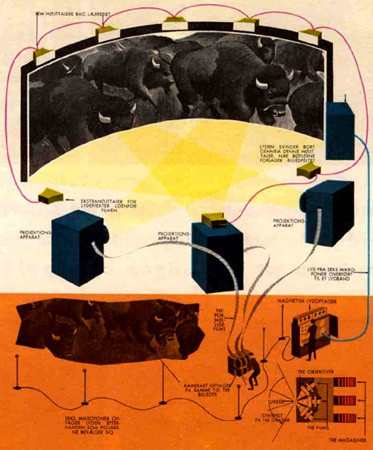 How
Cinerama works. 3 cameras photograph a scene on threee separate side-by-side
films in a 146 degree panorama. In the cinema, all three films are shown
side-by-side on a curved screen. This creates a sense of depth and reality
unlike anything you have ever seen. If you have not seen Cinerama yet, then
this is your chance. How
Cinerama works. 3 cameras photograph a scene on threee separate side-by-side
films in a 146 degree panorama. In the cinema, all three films are shown
side-by-side on a curved screen. This creates a sense of depth and reality
unlike anything you have ever seen. If you have not seen Cinerama yet, then
this is your chance.
allmovie.com: Filmed in panoramic Cinerama, this star-studded, epic
Western adventure is a true cinematic classic. Three legendary directors
(Henry Hathaway, John Ford, and George Marshall) combine their skills to
tell the story of three families and their travels from the Erie Canal to
California between 1839 and 1889. Spencer Tracy narrates the film, which
cost an estimated 15 million dollars to complete. In the first segment, "The
Rivers," pioneer Zebulon Prescott (Karl Malden) sets out to settle in the
West with his wife (Agnes Moorehead) and their four children. Along with
other settlers and river pirates, they run into mountain man Linus Rawlings
(James Stewart), who sells animal hides. The Prescotts try to raft down the
Ohio River in a raft, but only daughters Lilith (Debbie Reynolds) and Eve
(Carroll Baker) survive. Eve and Linus get married, while Lilith continues
on. In the second segment, "The Plains," Lilith ends up singing in a saloon
in St. Louis, but she really wants to head west in a wagon train led by
Roger Morgan (Robert Preston). Along the way, she's accompanied by the
roguish gambler Cleve Van Valen (Gregory Peck), who claims he can protect
her. After he saves her life during an Indian attack, they get married and
move to San Francisco. In the third segment, "The Civil War," Eve and Linus'
son, Zeb (George Peppard), fights for the Union. After he's forced to kill
his Confederate friend, he returns home and gives the family farm to his
brother. In the fourth segment, "The Railroads," Zeb fights with his
railroad boss (Richard Widmark), who wants to cut straight through Indian
territory. Zeb's co-worker Jethro (Henry Fonda) refuses to cut through the
land, so he quits and moves to the mountains. After the railway camp is
destroyed, Zeb heads for the mountains to visit him. In the fifth segment,
"The Outlaws," Lilith is an old widow traveling from California to Arizona
to stay with her nephew Zeb on his ranch. However, he has to fight a gang of
desperadoes first. How the West Was Won garnered three Oscars, for
screenplay, film editing, and sound production.
|
|
"Dance Craze" - 17:15
|
|
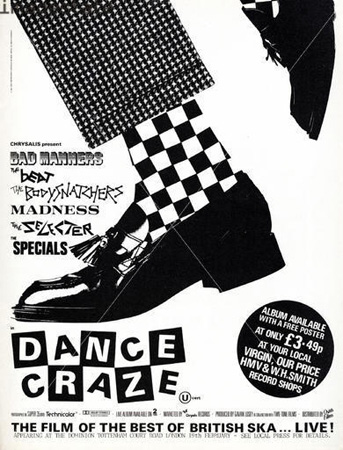 "Dance
Craze"
(1:29).
Filmed in: 35mm 4 perforations, 24 frames per second.
Principal photography in:
Super 35. Presented:
on the flat screen in
70mm with 6-track magnetic Dolby stereo
with split surrounds.
Aspect ratio: 1,66:1. Country of origin: UK. Production year: 1980.
World Premiere: 19.02.1981 Dominion, London, England. "Dance
Craze"
(1:29).
Filmed in: 35mm 4 perforations, 24 frames per second.
Principal photography in:
Super 35. Presented:
on the flat screen in
70mm with 6-track magnetic Dolby stereo
with split surrounds.
Aspect ratio: 1,66:1. Country of origin: UK. Production year: 1980.
World Premiere: 19.02.1981 Dominion, London, England.
Directed by Joe Massot. Produced by Gavrik Losey. Cinematography by Joe
Dunton. Film Editing by Ben Rayner & Anthony Sloman
Buster Bloodvessel (Himself (Bad Manners), Roddy Byers (Himself - The
Specials), Rhoda Dakar (Herself (the Bodysnatchers), Jerry Dammers ...
Himself (the Specials), Terry Hall (Himself (the Specials), Horace
Panter (Himself - The Specials, David Wakeling (Himself - The English
Beat
Youtube sample
allmovie.com: This film is a series of loud, knock-'em-out
performances by six different rock bands, and though it falls short of
the slick presentation of music videos, it has no lack of upbeat,
nonstop sound. The fans of Bad Manners, The Beat, The Bodysnatchers,
Madness, The Selecter, or The Specials will love the unrelenting beat
and the strutting, jumping, bouncing contortions of the performers -- a
workout beyond the wildest aerobic class. Non-fans may want to forego
the experience.
|
|
Joe Dunton (J.D.C. Scope lenses)
|
|
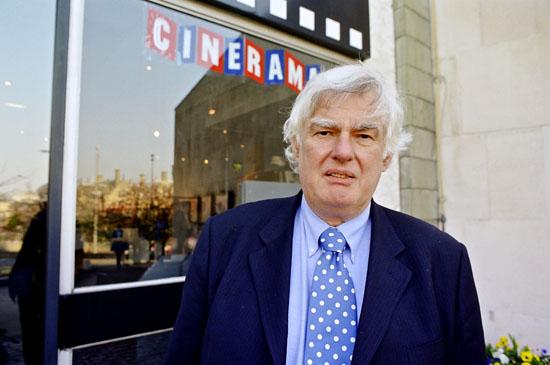 Joe
Dunton (J.D.C. Scope lenses). Picture by Thomas Hauerslev Joe
Dunton (J.D.C. Scope lenses). Picture by Thomas Hauerslev
Joe wins BAFTA award 2010
The British Academy of Film and Television Arts is delighted to announce
that Joe Dunton will receive the award for Outstanding British
Contribution to Cinema at the Orange British Academy Film Awards
ceremony at London’s Royal Opera House on Sunday 21 February 2010.
Joe Dunton is one of the off-camera heroes of the British film industry:
he has supported filmmakers and has been instrumental in the development
of equipment used globally by film productions in his career spanning
over four decades.
During his career, Joe has revolutionised the technology that is used as
standard in the industry today such as the first heated camera eyepiece,
the ladderpod and his work on Oliver was crucial in the development of a
system which is now commonly known as ‘video assist’, which allows
filmmakers to see what is being shot.
He has worked with the great filmmakers of our generation including
George Lucas, Steven Spielberg and Mike Leigh and he enjoyed a
particularly close relationship with Stanley Kubrick, whom he started
working with on A Clockwork Orange. He has most recently worked on the
Harry Potter series and Rob Marshall’s Nine, both of which are BAFTA-nominated
this year.
|
|
"Lawrence of Arabia" - 19:30
|
|
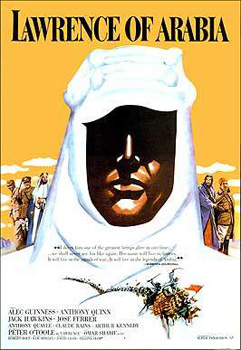  "Lawrence
of Arabia"
(3:47).
Filmed in: 65mm 5 perforations, 24 frames per second.
Principal photography in:
Super Panavision 70. Presented:
on the flat screen in
Super Panavision 70 with 6-track DTS stereo.
Aspect ratio: 2,21:1. Country of origin: USA. Production year: 1962.
World Premiere: 10.12.1962 Odeon Leicester Square, London, England. "Lawrence
of Arabia"
(3:47).
Filmed in: 65mm 5 perforations, 24 frames per second.
Principal photography in:
Super Panavision 70. Presented:
on the flat screen in
Super Panavision 70 with 6-track DTS stereo.
Aspect ratio: 2,21:1. Country of origin: USA. Production year: 1962.
World Premiere: 10.12.1962 Odeon Leicester Square, London, England.
Directed by David Lean. Written by Robert Bolt and Michael Wilson.
Produced by Sam Spiegel. Music by Maurice Jarre.
Cinematography by Freddie Young. Edited by Anne V. Coates
 Peter O'Toole (T.E. Lawrence), Alec Guinness (Prince Feisal), Anthony
Quinn (Auda abu Tayi), Jack Hawkins (General Lord Edmund Allenby), Omar
Sharif (Sherif Ali), José Ferrer (Turkish Bey, Anthony Quayle (Colonel
Brighton), Claude Rains (Mr. Dryden) & Arthur Kennedy (Jackson Bentley) Peter O'Toole (T.E. Lawrence), Alec Guinness (Prince Feisal), Anthony
Quinn (Auda abu Tayi), Jack Hawkins (General Lord Edmund Allenby), Omar
Sharif (Sherif Ali), José Ferrer (Turkish Bey, Anthony Quayle (Colonel
Brighton), Claude Rains (Mr. Dryden) & Arthur Kennedy (Jackson Bentley)
Movie poster art by
Howard Terpning
Restored version
+ full cast
& credit
Academy Award Wins:
Best Picture Sam Spiegel
Best Director David Lean
Best Cinematography, Color Freddie Young
Best Film Editing Anne V. Coates
Best Music, Score - Maurice Jarre
Best
Art Direction-Set Decoration, Color John Box, John Stoll, Dario Simoni
Best Sound John Cox
Academy Award Nominated:
Oscar Best Actor in a Leading Role Peter O'Toole
Best Actor in a Supporting Role Omar Sharif
Best Writing, Screenplay Based on Material from Another Medium
Robert Bolt & Michael Wilson (The nomination for Wilson was granted on 26
September 1995 by the Academy Board of Directors, after research at the WGA
found that the then blacklisted writer shared the screenwriting credit with
Bolt.)
Super Panavision 70 films
Youtube trailer
| |
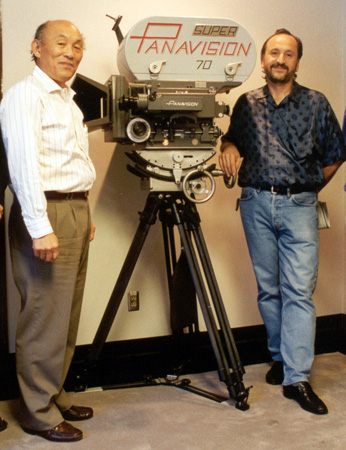 Panavision
65mm rack over camera used in "Lawrence of Arabia". Panavision's Tak Miyagishima and
Danish cinematographer and director Mikael Salomon in
1994. Image by Thomas Hauerslev Panavision
65mm rack over camera used in "Lawrence of Arabia". Panavision's Tak Miyagishima and
Danish cinematographer and director Mikael Salomon in
1994. Image by Thomas Hauerslev
allmovie.com:
This sweeping, highly literate historical epic covers the
Allies' mideastern campaign during World War I as seen through
the eyes of the enigmatic T. E. Lawrence (Peter O'Toole, in the
role that made him a star). After a prologue showing us
Lawrence's ultimate fate, we flash back to Cairo in 1917. A
bored general staffer, Lawrence talks his way into a transfer to
Arabia. Once in the desert, he befriends Sherif Ali Ben El
Kharish (Omar Sharif, making one of the most spectacular
entrances in movie history) and draws up plans to aid the Arabs
in their rebellion against the Turks. No one is ever able to
discern Lawrence's motives in this matter: Prince Feisal (Alec
Guinness) dismisses him as yet another "desert-loving
Englishman," and his British superiors assume that he's either
arrogant or mad. Using a combination of diplomacy and bribery,
Lawrence unites the rival Arab factions of Feisal and Auda Abu
Tayi (Anthony Quinn). After successfully completing his mission,
Lawrence becomes an unwitting pawn of the Allies, as represented
by Gen. Allenby (Jack Hawkins) and Dryden (Claude Rains), who
decide to keep using Lawrence to secure Arab cooperation against
the Imperial Powers. While on a spying mission to Deraa,
Lawrence is captured and tortured by a sadistic Turkish Bey
(Jose Ferrer). In the heat of the next battle, a wild-eyed
Lawrence screams "No prisoners!" and fights more ruthlessly than
ever. Screenwriters Robert Bolt and Michael Wilson used T. E.
Lawrence's own self-published memoir -The Seven Pillars of
Wisdom as their principal source, although some of the
characters are composites, and many of the "historical"
incidents are of unconfirmed origin. Two years in the making
(you can see O'Toole's weight fluctuate from scene to scene),
the movie, lensed in Spain and Jordan, ended up costing a
then-staggering 13 million and won seven Academy Awards,
including Best Picture and Best Director. The 1962 Royal
Premiere in London was virtually the last time that David Lean's
director's cut was seen: 20 minutes were edited from the film's
general release, and 15 more from the 1971 reissue. This
abbreviated version was all that was available for public
exhibition until a massive 1989 restoration, at 216 minutes that
returned several of Lean's favorite scenes while removing others
with which he had never been satisfied.
|
|
Sunday 27.03.2011
|
|
Cineramacana #2 - 10:00
|
|
 Screentalk:
Thomas Hauerslev in conversation
with Mr. Stanley Long of Circlorama fame. Screentalk:
Thomas Hauerslev in conversation
with Mr. Stanley Long of Circlorama fame.
From the Circlorama story:
Being by nature a technically minded film maker I was intrigued by the
prospect.
The process didn’t seem too much of a problem to me, and before long, after I had worked out how to do it.
Leonard Urry
agreed to funding a test and within a few days I was busy working out
how to go about it. Firstly I worked out the geometry, and found that
the eleven cameras would require to be fitted with 35mm lenses to cover
the picture circle. The cameras would be mounted on a circular aluminium
plate one half inch thick. Synchronisation would be achieved with mains
motors.
Read the full story:
The true history of Circlorama 1962-65
All about Stanley
Long
| |
"Doctor Zhivago" - 12:30
|
|
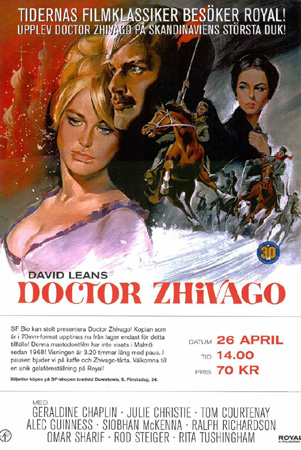 "Doctor
Zhivago" (3:17) + intermission. Filmed in: 35mm 4 perforations, 24
frames per second. Principal photography in: Panavision. Presented on:
The flat screen in a new 4K DCP print with a new 5.1 digital soundtrack.
Aspect ratio: 2,35:1. Country of origin: UK/USA. Production year: 1965.
World Premiere: 22.12.1965 USA. 26.04.1966 UK "Doctor
Zhivago" (3:17) + intermission. Filmed in: 35mm 4 perforations, 24
frames per second. Principal photography in: Panavision. Presented on:
The flat screen in a new 4K DCP print with a new 5.1 digital soundtrack.
Aspect ratio: 2,35:1. Country of origin: UK/USA. Production year: 1965.
World Premiere: 22.12.1965 USA. 26.04.1966 UK
Directed by David Lean. Screenplay by Robert Bolt. Produced by Carlo
Ponti. Original Music by Maurice Jarre. Cinematography by Freddie Young.
Film Editing by Norman Savage
Omar Sharif (Yuri), Julie Christie (Lara), Geraldine Chaplin (Tonya),
Rod Steiger (Komarovsky), Alec Guinness (Yevgraf), Tom Courtenay
(Pasha), Siobhan McKenna (Anna), Ralph Richardson (Alexander), Rita
Tushingham (The Girl), Klaus Kinski (Kostoyed)
Academy Awards 1966
Best Art Direction-Set Decoration, Color John Box, Terence Marsh, Dario
Simoni (2
Oscars)
Best Cinematography, Color Freddie Young
Best Costume Design, Color Phyllis Dalton
Best Music, Score - Maurice Jarre
Best Writing, Screenplay Based on Material from Another Medium Robert
Bolt
Nominated Oscar
Best Actor in a Supporting Role Tom Courtenay
Best Director David Lean
Best Film Editing Norman Savage
Best Picture Carlo Ponti
Best Sound A.W. Watkins (M-G-M British SSD) Franklin Milton (M-G-M SSD)
Youtube trailer
About showing 4k DCP on a 2k projector. The server scales a 4k DCP down
to 2K DCP and the projector shows it in 2K.
"Zhivago"'s
internet page
The Restoration
Robert A Harris talks about
the restoration on Home Theatre Forum
Motion Picture Editors Guild
| |
 allmovie.com: Based on the Nobel Prize-winning novel by Boris
Pasternak, Doctor Zhivago covers the years prior to, during, and after
the Russian Revolution, as seen through the eyes of poet/physician Yuri
Zhivago (Omar Sharif). In the tradition of Russian novels, a multitude
of characters and subplots intertwine within the film's 197 minutes
(plus intermission). Zhivago is married to Tonya (Geraldine Chaplin),
but carries on an affair with Lara (Julie Christie), who has been raped
by ruthless politician Komarovsky (Rod Steiger). Meanwhile, Zhivago's
half-brother Yevgraf (Alec Guinness) and the mysterious, revenge-seeking
Strelnikoff (Tom Courteney) represent the "good" and "bad" elements of
the Bolshevik revolution. Composer Maurice Jarre received one of Doctor
Zhivago's five Oscars, with the others going to screenwriter Robert
Bolt, cinematographer Freddie Young, art directors John Box and Terry
Marsh, set decorator Dario Simoni, and costumer Phyllis Dalton. The best
picture Oscar, however, went to The Sound of Music. allmovie.com: Based on the Nobel Prize-winning novel by Boris
Pasternak, Doctor Zhivago covers the years prior to, during, and after
the Russian Revolution, as seen through the eyes of poet/physician Yuri
Zhivago (Omar Sharif). In the tradition of Russian novels, a multitude
of characters and subplots intertwine within the film's 197 minutes
(plus intermission). Zhivago is married to Tonya (Geraldine Chaplin),
but carries on an affair with Lara (Julie Christie), who has been raped
by ruthless politician Komarovsky (Rod Steiger). Meanwhile, Zhivago's
half-brother Yevgraf (Alec Guinness) and the mysterious, revenge-seeking
Strelnikoff (Tom Courteney) represent the "good" and "bad" elements of
the Bolshevik revolution. Composer Maurice Jarre received one of Doctor
Zhivago's five Oscars, with the others going to screenwriter Robert
Bolt, cinematographer Freddie Young, art directors John Box and Terry
Marsh, set decorator Dario Simoni, and costumer Phyllis Dalton. The best
picture Oscar, however, went to The Sound of Music.
|
|
John Barry Tribute - "The Lion in Winter"
- 16:30
|
|
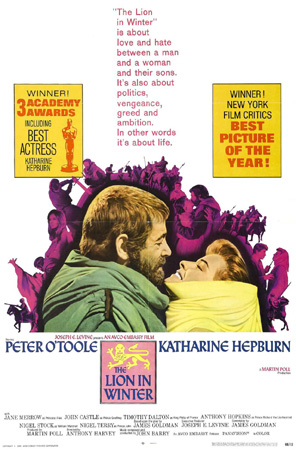  "The
Lion in Winter" (2:14) + intermission. Filmed in: 35mm 4 perforations, 24
frames per second. Principal photography in: Panavision. Presented on:
The flat screen in a vintage 70mm print with 6-track magnetic stereo.
Aspect ratio: 2,35:1. Country of origin: UK/USA. Production year: 1968.
World Premiere: 30.10.1968 USA. 29.12.1968 UK "The
Lion in Winter" (2:14) + intermission. Filmed in: 35mm 4 perforations, 24
frames per second. Principal photography in: Panavision. Presented on:
The flat screen in a vintage 70mm print with 6-track magnetic stereo.
Aspect ratio: 2,35:1. Country of origin: UK/USA. Production year: 1968.
World Premiere: 30.10.1968 USA. 29.12.1968 UK
Directed by Anthony Harvey. Screenplay by James Goldman. Produced by
Martin Poll. Original Music by John Barry. Cinematography by Douglas
Slocombe. Film Editing by John Bloom
Peter O'Toole (Henry II), Katharine Hepburn (Eleanor of Aquitaine),
Anthony Hopkins (Richard), John Castle (Geoffrey), Nigel Terry (John),
Timothy Dalton (Philip II), Jane Merrow (Alais)
Live in person Mrs. Jane Merrow
Academy Awards 1969
Best Actress in a Leading Role Katharine Hepburn
Best Music, Original Score for a Motion Picture (not a Musical) John
Barry
Best Writing, Screenplay Based on Material from Another Medium James
Goldman
Nominated Oscar
Best Actor in a Leading Role Peter O'Toole
Best Costume Design Margaret Furse
Best Director Anthony Harvey
Best Picture Martin Poll
Youtube trailer
|
|
allmovie.com: The year is 1183. Like many a modern-day
politician, Britain's King Henry II (Peter O'Toole) finds it
occasionally useful to take his wife out of mothballs and parade her
before the public. Henry's Queen Eleanor (Katharine Hepburn), long
exiled to a faraway castle, is "invited" to join Henry and their three
sons for a family reunion. In this way, Henry hopes to maintain a
stronghold on his Empire and to prevent the balance of power from
shifting to Eleanor or to one of his sons: Richard the Lion-Hearted
(Anthony Hopkins in his movie debut), Prince Geoffrey (John Castle), or
Prince John (Nigel Terry). Also on hand for the get-together is Henry's
mistress Princess Alais (Jane Merrow) -- who covets the King's influence
-- and the Princess' brother, King Philip of France (Timothy Dalton).
Despite Henry's efforts to keep his wife and offspring at arms' length
(and away from the throne), Eleanor successfully reunites the brood,
assuring that her power will not only be restored, but will last long
after her death.
|
|
|
|
|
Monday 28.03.2011
|
|
"Operation Crossbow" - 10:00
|
|
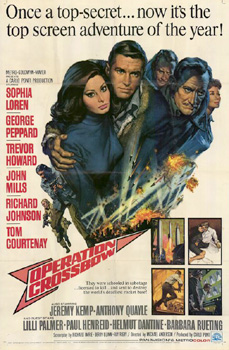  "Operation Crossbow" (1:55).
Filmed in: 35mm 4 perforations, 24 frames per second.
Principal photography in:
Panavision. Presented:
on the curved screen in Panavision 70 with 6-track magnetic stereo.
Aspect ratio: 2,21:1. Country of origin: UK. Production year: 1965.
World Premiere: 19.05.1965 Empire, Leicester Square, London, England. "Operation Crossbow" (1:55).
Filmed in: 35mm 4 perforations, 24 frames per second.
Principal photography in:
Panavision. Presented:
on the curved screen in Panavision 70 with 6-track magnetic stereo.
Aspect ratio: 2,21:1. Country of origin: UK. Production year: 1965.
World Premiere: 19.05.1965 Empire, Leicester Square, London, England.
Directed by: Michael Anderson. Screenplay: Emeric Pressburger, Derry
Quinn & Ray Rigby. Produced by: Carlo Ponti. Original Music by Ron
Goodwin. Cinematography by: Erwin Hillier. Film Editing by Ernest Walter
Multi language version, i.e. the English speak English, the Germans
speak German - and everything is subtitled in French.
Sophia Loren (Nora), George Peppard (Lt. John Curtis), Trevor Howard
(Professor Lindemann), John Mills (General Boyd), Richard Johnson
(Duncan Sandys), Tom Courtenay (Robert Henshaw), Anthony Quayle (Bamford),
Lilli Palmer (Frieda), Paul Henreid (General Ziemann), Richard Todd
(Wing Cmdr. Kendall)
allmovie.com: This big-budget, big-studio espionage film is set in the last years of World War II. George Peppard, Tom Courtenay and Jeremy Kemp parachute into Germany, with orders to destroy the Nazis' V-1 rocket base at Peenemunde. Given the order of billing, guess which special operative survives the longest. This being an MGM production, Peppard has time to commiserate with Sophia Loren, the wife of the Nazi collaborator whom Peppard is pretending to be. If you're wondering about the film's outcome, remember who won the war. Operation Crossbow failed badly in its first release; MGM, deciding that the title misled moviegoers into thinking that the picture was a "Robin Hood" derivation, cleared up matters by renaming the film The Great Spy Mission.
| |
Blake Edwards tribute: The Great Race - 12:30
|
|
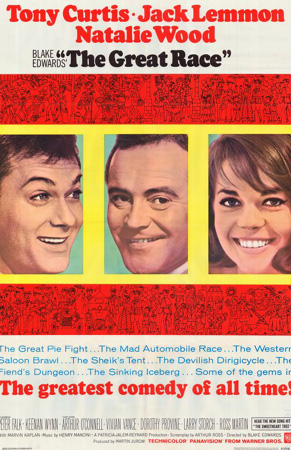  "The
Great Race"
(2:40).
Filmed in: 35mm 4 perforations, 24 frames per second.
Principal photography in:
Panavision. Presented:
on the curved screen in
Panavision 70 with 6-track magnetic stereo.
Aspect ratio: 2,21:1. Country of origin: USA. Production year: 1965.
World Premiere: 01.07.1965, USA. UK premiere 10.10.1965 Coliseum
Cinerama, London, England. "The
Great Race"
(2:40).
Filmed in: 35mm 4 perforations, 24 frames per second.
Principal photography in:
Panavision. Presented:
on the curved screen in
Panavision 70 with 6-track magnetic stereo.
Aspect ratio: 2,21:1. Country of origin: USA. Production year: 1965.
World Premiere: 01.07.1965, USA. UK premiere 10.10.1965 Coliseum
Cinerama, London, England.
Directed by Blake Edwards. Screenplay Arthur A. Ross. Produced by Martin
Jurow producer. Original Music by Henry Mancini. Cinematography by
Russell Harlan. Film Editing by Ralph E. Winters.
Jack Lemmon (Professor Fate / Crown Prince Frederick Hoepnick). Tony
Curtis (The Great Leslie), Natalie Wood (Maggie Dubois), Peter Falk
(Maximilian Meen), Keenan Wynn (Hezekiah Sturdy), Arthur O'Connell
(Henry Goodbody)
Academy Awards 1966
Best Effects, Sound Effects Treg Brown
Nominated Oscar
Best Cinematography, Color Russell Harlan
Best Film Editing Ralph E. Winters
Best Music, Original Song Henry Mancini (music) Johnny Mercer (lyrics)
For the song "The Sweetheart Tree"
Best Sound George Groves (Warner Bros. SSD)
Youtube trailer
|
|
allmovie.com: Tony Curtis stars as The Great Leslie, a hero
among heroes whose purity of heart is manifested by his spotlessly white
wardrobe. Leslie's great rival, played by Jack Lemmon, is Professor
Fate, a scowling, mustachioed, top-hatted, black-garbed villain. Long
envious of Leslie's record-setting accomplishments with airships and sea
craft, Professor Fate schemes to win a 22,000-mile auto race from New
York City to Paris by whatever insidious means possible. The problem is
that Fate is his own worst enemy: each of his plans to remove Leslie
from the running (and from the face of the earth) backfires. Leslie's
own cross to bear is suffragette Maggie Dubois (Natalie Wood), who also
hopes to win the contest and thus strike a blow for feminism. The race
takes all three contestants to the Wild West, the frozen wastes of
Alaska, and, in the longest sequence, the mythical European kingdom of
Carpania. This last-named country is the setting for a wild Prisoner of
Zenda spoof involving Professor Fate and his look-alike, the foppish
Carpanian king. When Leslie and Fate approach the finish line at the
Eiffel Tower, Leslie deliberately loses to prove his love for Maggie.
Professor Fate cannot stand winning under these circumstances, thus he
demands that he and Leslie race back to New York. The supporting cast
includes Peter Falk as Fate's long-suffering flunkey Max, Keenan Wynn as
Leslie's faithful general factotum, Dorothy Provine as a brassy saloon
singer, Larry Storch as ill-tempered bandit Texas Jack, and Ross Martin
as Baron Von Stuppe. The film also yielded a hit song, Henry Mancini and
Johnny Mercer's The Sweetheart Tree. The Great Race was dedicated to
"Mr. Laurel and Mr. Hardy".
|
|
|
|
|
Go: back - top - back issues - news index
Updated
22-01-25 | |
|
"Appearing in "Limelight" gave me the most joy
of any film I was in"
"I was offered the role of Esther in "Ben Hur", but didn't get it in the end. I
wanted to be in "Ben Hur""
"I admire Ken Russel"
"I turned down a role in "El Cid", because it meant I had to be away from my
1-year old daughter for 6 months."
"I don't know if I'm a lady, and I don't give a damm"
"I became and actress because of Snow White when I was little"
"YouTube - the greatest thing for actors - ever"
|


 "Goya
– oder der arge Weg der Erkenntnis" / "Goya – or the hard way to enlightment"
"Goya
– oder der arge Weg der Erkenntnis" / "Goya – or the hard way to enlightment"

 70mm frame scan by Schauburg Kino
70mm frame scan by Schauburg Kino Reception
guests 2009 - the delegation from Kino Mir 70 in Krnov.
Reception
guests 2009 - the delegation from Kino Mir 70 in Krnov. "The
Bridge on the River Kwai" (2:32). Filmed in:
35mm 4 perforations, 24 frames per second. Principal photography in:
CinemaScope. Presented on: The flat screen in a new 4K DCP print
with a new 5.1 digital soundtrack. Aspect ratio: 2,55:1.
Country of origin: UK/USA. Production year: 1957. World
Premiere: 02.10.1957 (UK).
"The
Bridge on the River Kwai" (2:32). Filmed in:
35mm 4 perforations, 24 frames per second. Principal photography in:
CinemaScope. Presented on: The flat screen in a new 4K DCP print
with a new 5.1 digital soundtrack. Aspect ratio: 2,55:1.
Country of origin: UK/USA. Production year: 1957. World
Premiere: 02.10.1957 (UK). Including
"Shellarama" in Super Technirama 70
Including
"Shellarama" in Super Technirama 70 "The
Dark Crystal" (1:36). Filmed in: 35mm 4 perforations, 24 frames per
second. Principal photography in: Panavision. Presented on: The flat
screen in a vintage 70mm print with 6-track Dolby Stereo. Aspect ratio:
2,21:1. Country of origin: UK/USA. Production year: 1982.
World
Premiere: 17.12.1982 (USA) & 17.02.1983 (UK).
"The
Dark Crystal" (1:36). Filmed in: 35mm 4 perforations, 24 frames per
second. Principal photography in: Panavision. Presented on: The flat
screen in a vintage 70mm print with 6-track Dolby Stereo. Aspect ratio:
2,21:1. Country of origin: UK/USA. Production year: 1982.
World
Premiere: 17.12.1982 (USA) & 17.02.1983 (UK). “How the West Was Won”
(2:42) + intermission.
“How the West Was Won”
(2:42) + intermission.
 How
Cinerama works. 3 cameras photograph a scene on threee separate side-by-side
films in a 146 degree panorama. In the cinema, all three films are shown
side-by-side on a curved screen. This creates a sense of depth and reality
unlike anything you have ever seen. If you have not seen Cinerama yet, then
this is your chance.
How
Cinerama works. 3 cameras photograph a scene on threee separate side-by-side
films in a 146 degree panorama. In the cinema, all three films are shown
side-by-side on a curved screen. This creates a sense of depth and reality
unlike anything you have ever seen. If you have not seen Cinerama yet, then
this is your chance. 
 Joe
Dunton (J.D.C. Scope lenses). Picture by Thomas Hauerslev
Joe
Dunton (J.D.C. Scope lenses). Picture by Thomas Hauerslev 


 Panavision
65mm rack over camera used in "Lawrence of Arabia". Panavision's Tak Miyagishima and
Danish cinematographer and director Mikael Salomon in
1994. Image by Thomas Hauerslev
Panavision
65mm rack over camera used in "Lawrence of Arabia". Panavision's Tak Miyagishima and
Danish cinematographer and director Mikael Salomon in
1994. Image by Thomas Hauerslev Screentalk:
Thomas Hauerslev in conversation
with Mr. Stanley Long of Circlorama fame.
Screentalk:
Thomas Hauerslev in conversation
with Mr. Stanley Long of Circlorama fame. "Doctor
Zhivago" (3:17) + intermission. Filmed in: 35mm 4 perforations, 24
frames per second. Principal photography in: Panavision. Presented on:
The flat screen in a new 4K DCP print with a new 5.1 digital soundtrack.
Aspect ratio: 2,35:1. Country of origin: UK/USA. Production year: 1965.
World Premiere: 22.12.1965 USA. 26.04.1966 UK
"Doctor
Zhivago" (3:17) + intermission. Filmed in: 35mm 4 perforations, 24
frames per second. Principal photography in: Panavision. Presented on:
The flat screen in a new 4K DCP print with a new 5.1 digital soundtrack.
Aspect ratio: 2,35:1. Country of origin: UK/USA. Production year: 1965.
World Premiere: 22.12.1965 USA. 26.04.1966 UK



